Plant This: ‘Old Mexico’ prickly pear
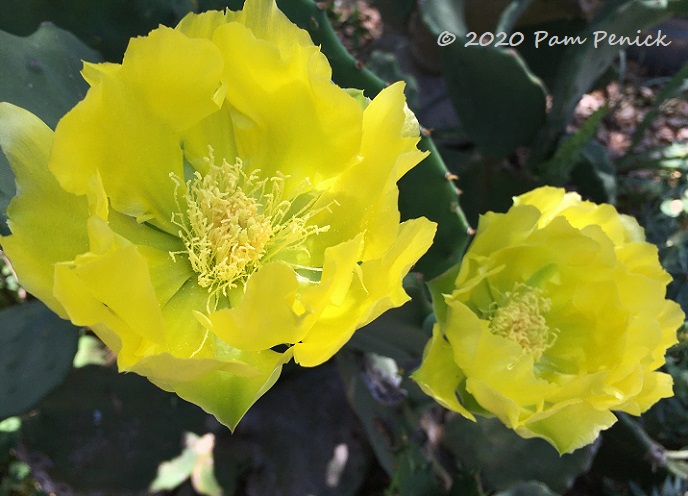
Everyone needs at least one beautiful beast of a plant in their garden, a tough old boot intent on annexing adjacent real estate, but not so quickly that you can can’t beat it back. Texas tough. Meet ‘Old Mexico’ prickly pear (Opuntia gomei), also called wavy-leaf prickly pear.
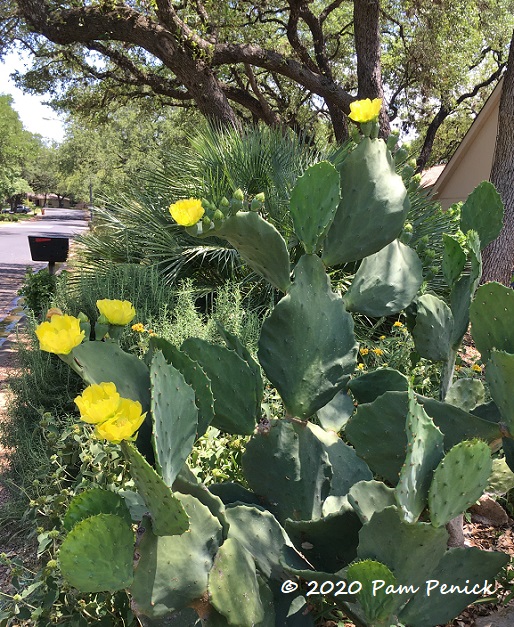
Its lemon-yellow, ruffled flowers glow like cups of pure sunshine in late spring. Each flower lasts just one day, but mature plants produce dozens, extending the floral show for a couple of weeks.
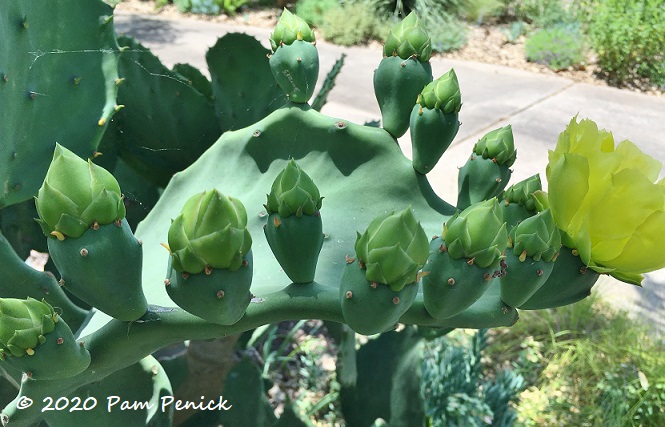
More flower buds ready to pop
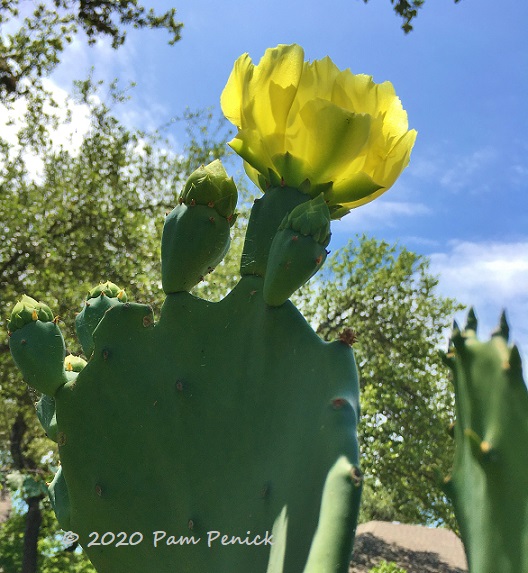
Its large leaf pads have a wavy shape with scalloped edges. While technically spineless, it does have tiny, nearly invisible glochids that embed themselves in skin and cause pain if you handle a pad with bare fingers. Just don’t. I speak from experience.
Don’t use cloth or leather gloves to handle it either unless you want glochids permanently embedded in them. Instead use BBQ tongs to handle fallen or pruned pads. Sometimes I’ll just use a shovel blade or the sole of my shoe to knock off a pad at the joint and then scoop it up with a shovel.
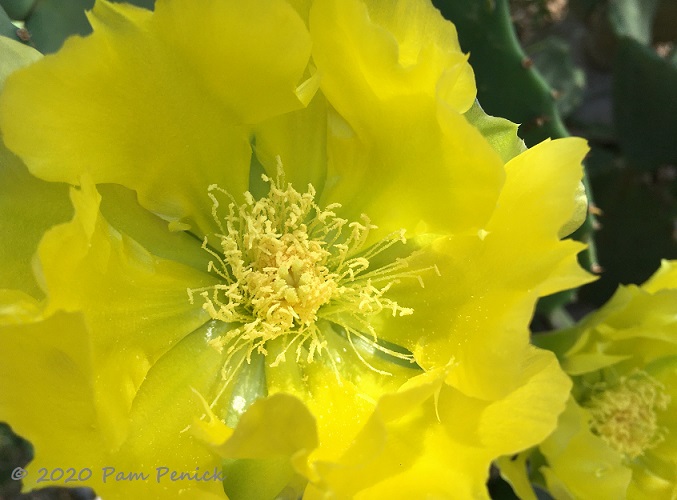
Why bother knocking or pruning off pads? I mentioned that ‘Old Mexico’ is a monster, didn’t I? It grows to about 4 feet tall and wide, and then it has a clever trick to expand its territory. A heavy “branch” of several pads will fall over, and where each pad touches the ground it takes root. In this way, ‘Old Mexico’ prickly pear can creep along in a garden in slow motion, and eventually you’ve got more prickly pear than you know what to do with.
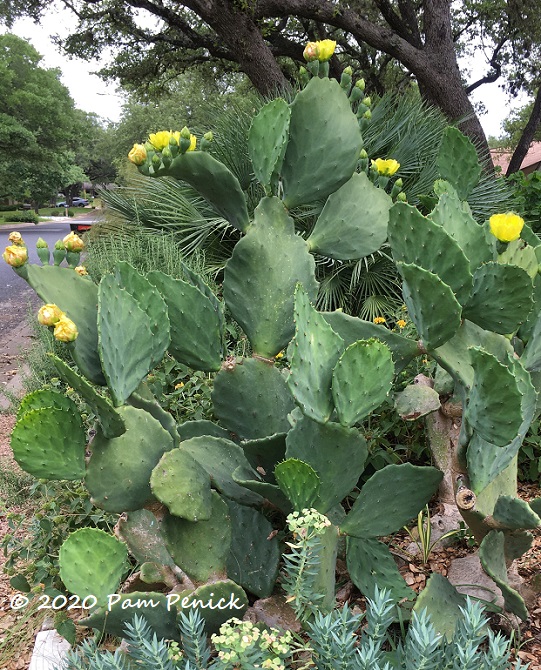
Still, it’s pretty! And evergreen. And cool looking. And super drought tolerant and heat tolerant. Plus deer don’t eat it, nor have they ever antlered it in my garden (no guarantees, of course). Keep it where you want it, and shape it to your taste, by pruning off pads as needed. You can easily use the pruned pads to root new plants for yourself or give them away to daring friends. Just toss them onto bare soil and stand back.
Mine grows in dappled shade all day until late afternoon, but full sun is ideal. ‘Old Mexico’ prickly pear is native to far south Texas, so it can pout and droop sadly when Austin gets a hard freeze, especially one that lasts for a day or more. (It might suffer more in colder parts of town, in low spots or outside the city.) But it perks up with warmer weather and always looks good again by spring.
Note: My Plant This posts are written primarily for gardeners in Central Texas. The plants I recommend are ones I’ve grown myself and have direct experience with. Check online forums for your region or local independent nurseries to see if a particular plant might work in your area.
__________________________
Digging Deeper
Come learn about gardening and design at Garden Spark! I organize in-person talks by inspiring designers, landscape architects, authors, and gardeners a few times a year in Austin. These are limited-attendance events that sell out quickly, so join the Garden Spark email list to be notified in advance; simply click this link and ask to be added. Season 8 kicks off in fall 2024. Stay tuned for more info!
All material © 2024 by Pam Penick for Digging. Unauthorized reproduction prohibited.


I love my Eastern prickly pear, Opuntia humifusa, with its stunning blooms in June and July. Thank you for your advice, Pam, on pruning pads using BBQ tongues. It’s not a monster like my son’s Arizona species, but I like having a plant similar to his in my cottage garden.
Cactus blooms are spectacular. They alone make it worth the spiny risks of growing cacti. But of course plenty of us love the shape of the plants too and the way those spines catch the light. They are beautiful! There’s just no reason to love glochids though – ha!
I adore the idea that you’re growing a plant similar to one your son has in his garden on the other side of the country.
Holy moly, that’s a gorgeous monster! I discovered that even spineless Opuntia can leave little pricklies in your gloves.
They sure can. Evil glochids! But I adore the plant otherwise.
I think we saw a wall of these near Tait Moring’s garden during the Austin Fling? I was in awe. I also love your description of it slowly creeping along.
Yes! Tait does have a hedge of Old Mexico opuntia. He’s been posting cactus flower pics on his Instagram for weeks now.
Hi Pam, how can you weed beneath this plant? It seems to dangerous to go near. Also, if I did one day want to remove it, is it difficult to eradicate? For years I’ve wanted to plant Yucca In my Georgia garden but I’m afraid I’ll never be rid of it. Is this similar?
If you keep its shape largely upright by pruning off drooping pads, it’s not hard to weed around. I wouldn’t want to be pulling up weeds constantly though, so make sure you first eradicate troublesome weeds in the planting area, like Bermudagrass and nutgrass. A loose, one-inch layer of shredded bark mulch around it will help keep down weeds, but don’t pile up mulch against its woody base. That could cause rot. It’s easy to over-mulch xeric plants like cactus, agave, and yucca, especially if you put out fresh mulch once a year.
I kind of went off on a tangent there. To answer your other questions, yes, I’ve found it easy to remove prickly pear if I no longer want it, assuming it’s a spineless variety. I won’t plant the spiny sort in the ground. They are just too hard to work around.
Yucca is a very adaptable plant, in my experience, so long as it has sharp drainage. In your area I’d plant it on a gravelly mound so water can drain away. It can be a little challenging to remove if you change your mind. Pieces of roots that get left in the ground will resprout new plants — at least in my region they do — so you just have to dig deep and make sure to get all the roots out.
Good advice. Thanks for the detailed answer, Pam. I’m so glad I stumbled onto your website! I look forward to all your posts and your pictures are just luscious. Take care.
I love the old mexico prickly pear. I got a few pieces from my job where they pulled them out. They lay on my rocky ground unplanted for about a year and lived. Finally planted them about six months ago and they look great!! Flowers all over them and very perky. You’d never know they were half dead when planted.
It’s hard to imagine a tougher plant, isn’t it?
I came across your posting by accident as I was searching for images of my Old Mexico prickly pear. Unfortunately, the February freeze really damaged mine and I’m looking for some sizable replacement pads. I know it grows fast, and I’m willing to be patient. Any ideas on the best place to purchase, or any freebies that are out there? I love this cactus and really grieve its loss in my landscape.Your specimen is gorgeous! Hope it made it through the February freeze.
Alas, the freeze killed it to the ground, as you can see in this post: https://www.penick.net/digging/?p=74484. But I was delighted today to see tiny leaf nubs growing from the cut-back base of the plant. I’m hopeful it will one day be big and beautiful again. Give yours time, and maybe it’ll come back from the roots too. As for where to purchase, try any of the local nurseries. Plant supplies are low with everyone buying replacements, so you’ll probably have to look around for it.